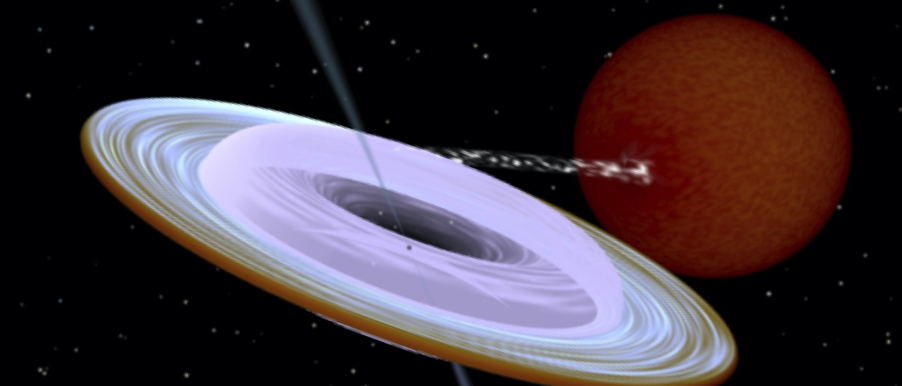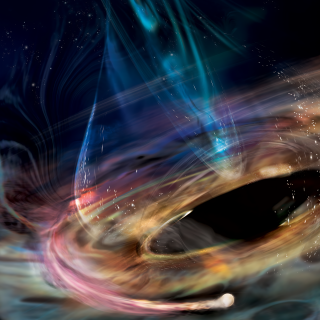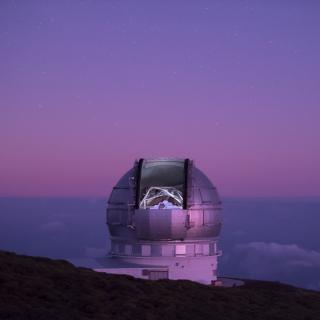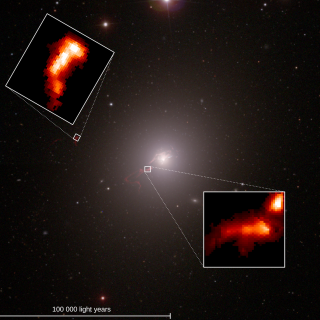Artist impression of the X-ray binary system MAXI J1820+070 containing a black hole (small black dot at the center of the gaseous disk) and a companion star. A narrow jet is directed along the black hole spin axis, which is strongly misaligned from the rotation axis of the orbit. Image produced with Binsim (credit: R. Hynes).
Astronomers have found a black hole which challenges current theoretical models for the formation of these compact objects, using telescopes at the Roque de los Muchachos Observatory, (Garafía, La Palma, Canary Islands). The results are published today in the journal Science.
The observations, by this team of researchers, led by the University of Turku (Finland) with participation by the Instituto de Astrofísica de Canarias (IAC) find a difference of more than 40 degrees between the axis of the orbit of the X-ray binary MAXI J1820+070 and the axis of rotation of the black hole. The existence of a black hole in this binary star system was found previously by a team of researchers at the IAC with observations using the Gran Telescopio Canarias (GTC) and the William Herschel Telescope (WHT) of the Isaac Newton Group of Telescopes, both at the Roque de los Muchachos Observatory.
Often for the space systems with smaller objects orbiting around the central massive body, the own rotation axis of this body is to a high degree aligned with the rotation axis of its satellites. This is true also for our solar system: the planets orbit around the Sun in a plane, which roughly coincides with the equatorial plane of the Sun. The inclination of the Sun rotation axis with respect to orbital axis of the Earth is only seven degrees.
"The expectation of alignment, to a large degree, does not hold for the bizarre objects such as black hole X-ray binaries”, states Juri Poutanen, Professor of Astronomy at the University of Turku and the lead author of the publication. And he adds: “The black holes in these systems were formed as a result of a cosmic cataclysm − collapse of a massive star. Now we see the black hole dragging matter from the nearby, lighter companion star orbiting around it. We see bright optical and X-ray radiation as the last sigh of the infalling material, and also radio emission from the relativistic jets expelled from the system."
By observing the signal from these jets the researchers have been able to make a very precise estimate of the direction of the rotation axis of the black hole. About a year after it identification, with the MAXI instrument on the International Space Station the quantity of gas falling into the black hole began to get less, and the system faded. From then on a significant part of the emission is coming from the companion star. By studying this star with the GTC using spectroscopy it has been possible to measure the inclination of its orbit and it turned out to be practically the same as the inclination of the jet.
To establish the spatial orientation of the orbit we also need to know the angular position of the binary in the plane of the sky” explains Manuel Pérez Torres, an IAC researcher and a co-author of the article. “This measurement was obtained by studying the polarization of the radiation emitted by the binary. This information, combined with previous results, has given us a detailed image of the structure of the binary and the 3D orientation of its components, leading to the discovery of a black hole with rotates, surprisingly, very inclined with respect to its orbit.
The results published in Science magazine open interesting prospects towards studies of black hole formation and evolution of such systems, as such extreme misalignment is hard to get in many black hole formation and binary evolution scenarios.
“The difference of more than 40 degrees between the orbital axis and the black hole spin was completely unexpected. Scientists have often assumed this difference to be very small when they have modeled the behavior of matter in a curved time space around a black hole. The current models are already really complex, and now the new findings force us to add a new dimension to them”, Poutanen states.
Before writing this article, a team of astrophysicists led by IAC researcher Manuel Pérez Torres had confirmed the presence of a black hole, and derived the inclination of the orbit with data also obtained on La Palma, with the Gran Telescopio Canarias (GTC) and the William Herschel Telescope (WHT).
However the key observations for the present study were made with the Liverpool Telescope and the DIPol-UF instrument on the Nordic Optical Telescope, which belongs to the Universities of Turku (Finland) and Aarhus (Denmark) both at the Roque de los Muchachos Observatory, La Palma.
Poutanen, J. et al. 24 Feb 2022. Black hole spin–orbit misalignment in the x-ray binary MAXI J1820+070. Science. Vol 375, Issue 6583. pp. 874-876. DOI: https://doi.org/10.1126/science.abl4679
- Dynamical Confirmation of a Black Hole in MAXI J1820+070 (https://cutt.ly/TPSErvk)
- The Binary Mass Ratio in the Black Hole Transient MAXI J1820+070 (https://cutt.ly/EPSEcon)
Contacto en el IAC: mapt [at] iac.es (mapt[at]iac[dot]es)



